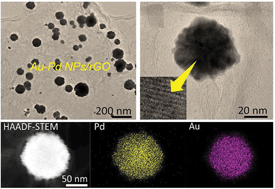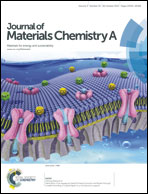Reduced graphene oxide nanosheets decorated with Au, Pd and Au–Pd bimetallic nanoparticles as highly efficient catalysts for electrochemical hydrogen generation
Abstract
Reduced graphene oxide (rGO) nanosheets decorated with gold nanoparticles (Au NPs/rGO), palladium nanoparticles (Pd NPs/rGO), and gold–palladium bimetallic nanoparticles (Au–Pd NPs)/rGO are synthesized by a simple solution chemistry approach using ascorbic acid as an eco-friendly reducing agent. These materials are characterized by high resolution transmission electron microscopy (HRTEM), X-ray diffraction (XRD), X-ray photoelectron spectroscopy (XPS), high-angle annular diffraction field-scanning transmission electron microscopy (HAADF-STEM) and thermogravimetric analysis (TGA). The as-prepared nanocomposites are tested as electrocatalysts for efficient hydrogen evolution in deaerated 0.5 M H2SO4 aqueous solution using polarization and impedance measurements. Experimental findings show that the tested catalysts exhibit fast hydrogen evolution kinetics with onset potentials as low as −17, −7.2, and −0.8 mV vs. RHE for Au NPs/rGO, Pd NPs/rGO, and Au–Pd NPs/rGO, respectively. In addition, Tafel slopes of 39.2, 33.7 and 29.0 mV dec−1 and exchange current densities of 0.09, 0.11, and 0.47 mA cm−2 are measured for Au NPs/rGO, Pd NPs/rGO, and Au–Pd NPs/rGO, respectively. The tested materials not only maintain their high performance after 5000 sweep cycles, but their activity is simultaneously enhanced after this aging process. These findings reveal that the tested catalysts, particularly Au–Pd NPs/rGO, are promising candidates among other noble metal catalysts for hydrogen evolution, approaching the commercial Pt/C catalyst (onset potential: 0.0 mV, Tafel slope: 31 mV dec−1, and exchange current density: 0.78 mA cm−2). The high hydrogen evolution reaction (HER) activity of such materials is likely due to the abundance of active catalytic sites, the increased electrochemically accessible surface area and significantly improved electrochemical conductivity.


 Please wait while we load your content...
Please wait while we load your content...